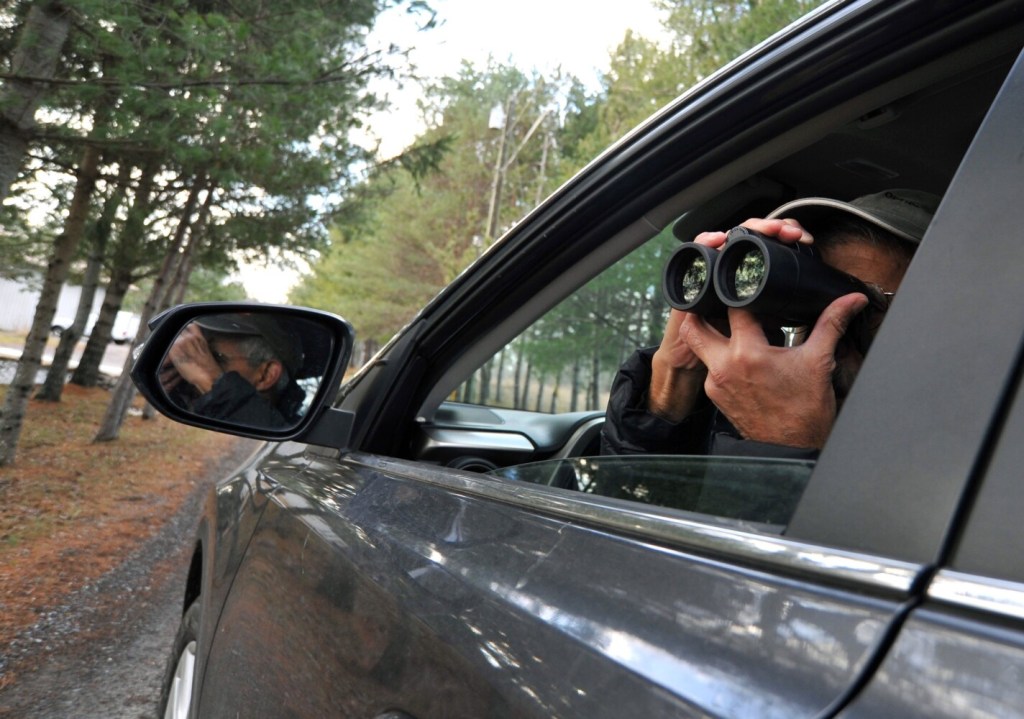WINSLOW — Jose and Lea Ramirez might be mistaken for detectives as they drive around in their gray Toyota RAV4, peering out of windows, stopping, listening and snapping photographs.
The Waterville couple are investigators of sorts — but it is birds they observe, not people.
The Ramirezes were taking part Sunday in the 120th annual National Audubon Christmas Bird Count, an activity that tracks bird data and provides valuable insight into bird populations and the health of their habitats. The count helps wildlife organizations implement conservation strategies.
The couple organizes the Waterville Circle of the Maine Audubon Christmas Bird Count, one of many counts held statewide.
The local count comprises about 30 people who go off in groups within a 15-mile radius of Colby College to count birds and document species as part of the daylong activity that, nationally, takes place between Dec. 14 and Jan. 5.
On Sunday, the Ramirezes drove along Garland Road in Winslow, meandering in and out of roads lines with bushes and trees, listening and looking. They can identify birds by the sounds of their chirps.
“You hear it before you see it and if you hear it, that counts, too,” Lea Ramirez, 64, said.

A Cooper’s hawk is perched Sunday in a maple tree during the National Audubon Society Christmas Bird Count in Winslow. Morning Sentinel by Rich Abrahamson
As her husband, 67, drove, she held a clipboard, documenting the species and number of birds they saw or heard. They started counting at 7:15 a.m., and by 9:15 a.m. had counted 115 birds of varying species including blue jays, European starlings, black-capped chickadees, house finches, nuthatches, northern cardinals, American goldfinches, crows and tufted titmouse.
At the end of the day, the birders would all meet at the Ramirezes’ home to compare and compile data. Lea Ramirez said they typically identify about 50 species and last year, the Waterville-area group counted 9,803 birds.
“Psh, psh, psh, psh,” Jose Ramirez said, calling to birds as he pulled up to a quiet stand of trees off Garland Road. “Did you hear that little peep? That’s a chickadee.”
Shortly afterward, he would make an exciting find: Entering the driveway of Garland Road Small Animal Hospital, he spotted what he at first thought was a crow, high up in a maple tree, but then realized it was something else.
“That’s a Cooper’s hawk right there,” he said. “It’s the first one I’ve seen in the last two weeks.”
The large, brown-and-tan-speckled bird was perched regally on a high branch, its tail open and the wind catching the feathers on its neck and tail.
“It is similar to the sharped-shinned hawk,” Jose Ramirez said. “The female of the sharped-shinned hawk and the male of the Cooper’s hawk are basically the same size.”
Soon, one, two, three and then four crows flew to nearby branches of the tree, appearing to gang up on the hawk.
“They don’t like hawks because they’ll eat their babies and usually they’ll try to scare it away, but I think they’re looking at us, too,” Jose Ramirez said of the crows.
The couple said they typically see a Cooper’s hawk every other year when they do the Christmas count, and they always cover the same territory.
Maine Audubon’s mission is to conserve the state’s wildlife and wildlife habitat by engaging people of all ages in education, conservation and action.
Late last week, Doug Hitchcox, Maine Audubon’s staff naturalist, said bird counters Sunday would include those driving around, like the Ramirezes, and people counting birds at feeders. He said it is impossible to count every bird, but over the years, patterns emerge that prove valuable in documenting species, population and habitat.
It’s kind of a fascinating story,” Hitchcox said of the Christmas Bird Count. “It used to happen on Christmas Day and it was called the ‘Christmas Hunt,’ where people went out and shot birds. They spent the entire day shooting birds. Whoever had the largest pile of birds won the bird count.”
December marks the official kickoff for the winter portion of the Maine Bird Atlas, a citizen-scientist project that extends from Dec. 14 to March 15 and overlaps with the Christmas Count, according to Hitchcox.
The goal is to map the distribution and abundance of species over a large geographic area during a fixed period of time. Those taking part need not be experienced — they may count birds, for instance, in their backyards and other places they go, such as the grocery store.
Those interested in taking part should go to Maine.gov/birdatlas or call Hitchcox at Maine Audubon at (207) 781-2330.
“We already have 1,200 volunteers for the breeding summer portion of it, so we’re trying to get people to do winter as well,” he said.
Lifelong bird lovers, the Ramirezes — Jose is an orthopedic surgeon and Lea a stay-home mother — take part in the Maine Bird Atlas and other projects, and have watched birds in many countries, including China and Thailand.
“We just spent a month in Madagascar looking at birds,” Lea Ramirez said.

Jose Ramirez uses binoculars as he observes birds Sunday during the National Audubon Society Christmas Bird Count. Morning Sentinel photo by Rich Abrahamson Buy this Photo
Married 42 years, the couple said when they were younger, they enjoyed exploring the outdoors. Their love of birds followed.
“There are so many and they’re all over the world now when you travel,” Lea Ramirez said. “There’s a whole bird world out there. It’s social, too, with other birders.
“You have this immediate connection with someone who is a foreigner. You never know what you’re going to see. You’re outside, observing nature. When you see birds, you see other things as well.”
They worry about some birds losing their habitats because of tree cutting and building.
“In other countries,” Jose Ramirez said, “that’s probably the number-one reason for loss of birds.”
Send questions/comments to the editors.












Comments are no longer available on this story